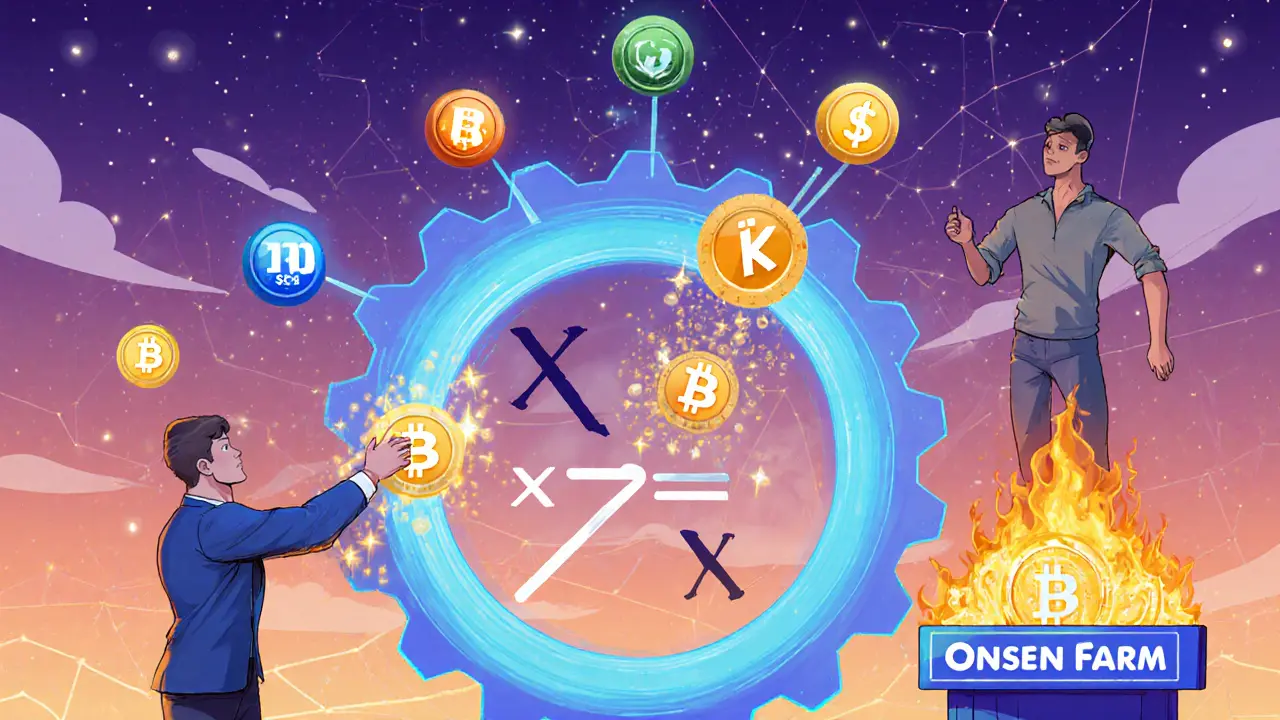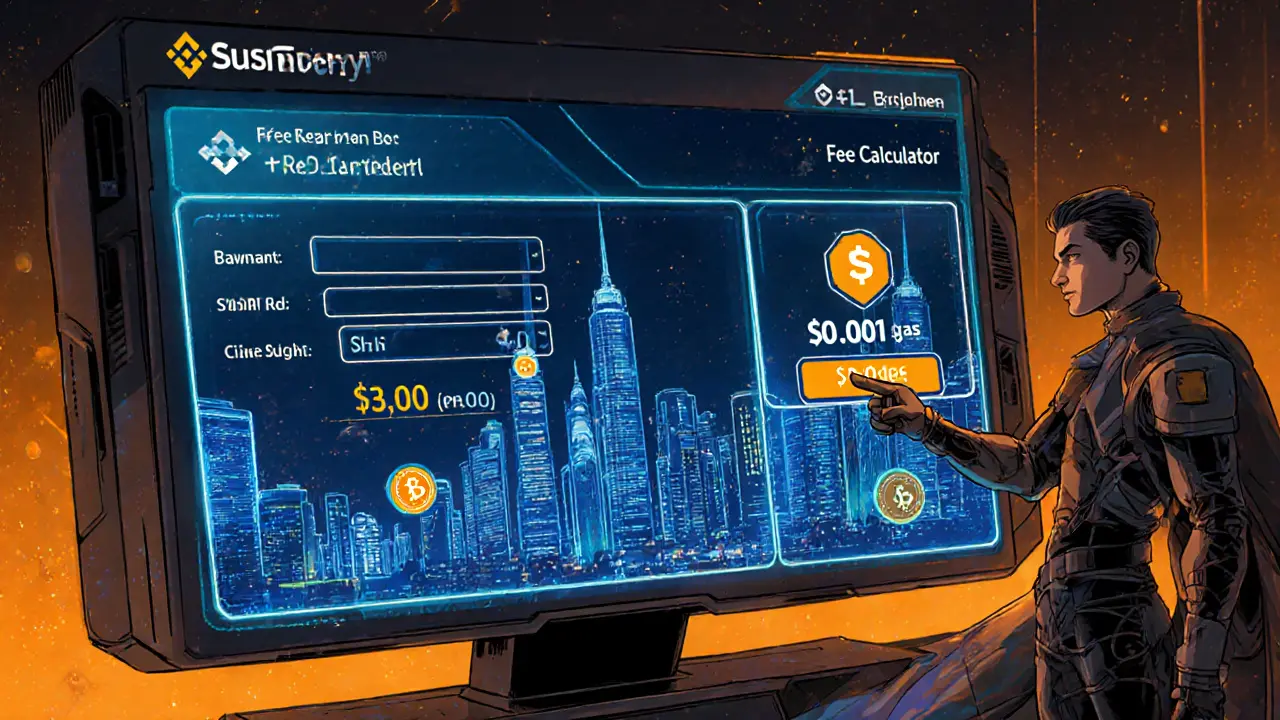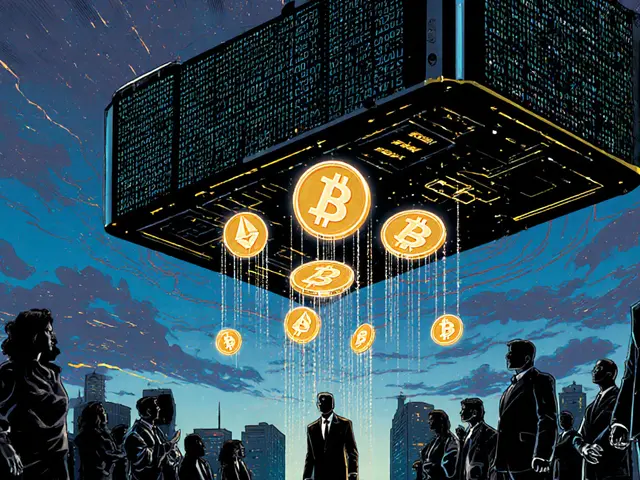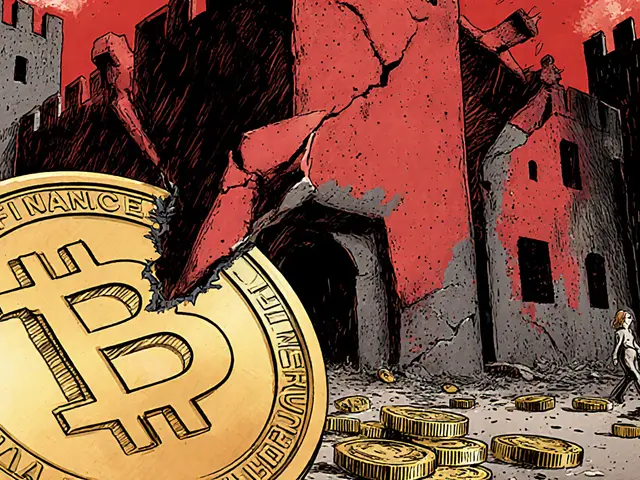SushiSwap BSC Review: Fees, Liquidity & Yield Farming Explained
SushiSwap BSC Fee Calculator
Calculate Your Trading Costs
Estimate your trading fees on SushiSwap BSC compared to Ethereum-based alternatives.
Your Estimated Trading Costs
SushiSwap BSC:
Fee: $3.00
Gas: $0.01
Total: $3.01
Savings with SUSHI Staking: $0.03
Uniswap (Ethereum):
Fee: $3.00
Gas: $12.00
Total: $15.00
Savings over SushiSwap: $11.99
💡 Tip: With SUSHI staking, you save $0.03 per $1000 trade on BSC!
Fee Comparison Table
| Platform | Base Swap Fee | Avg. Gas Cost (USD) | Rebate to Stakers |
|---|---|---|---|
| SushiSwap (BSC) | 0.30% | $0.01 | 0.025% (SUSHI holders) |
| Uniswap (Ethereum) | 0.30% | $12.00 | None |
| PancakeSwap (BSC) | 0.20% | $0.01 | 0.02% (CAKE holders) |
* Gas costs shown are approximate and vary with network congestion.
Quick Takeaways
- Operating on Binance Smart Chain gives SushiSwap sub‑$0.01 transaction costs and fast confirmations.
- Fees are 0.30% per swap; 0.025% of that is rebated to SUSHI stakers.
- Liquidity pools on BSC hold roughly $1.2B, with the SUSHI/ETH pair offering double rewards.
- Governance remains concentrated: nine core members, five control contract upgrades.
- Great for beginners thanks to the themed UI and Sushi Academy, but no demo mode means real funds are always at risk.
Ever wondered whether a decentralized exchange (DEX) on Binance Smart Chain lives up to the hype? This SushiSwap BSC review breaks down the platform’s fees, liquidity depth, earning tools, and the governance quirks that keep the community buzzing.
SushiSwap is a multi‑chain decentralized finance platform that functions as an automated market maker (AMM) and crypto exchange. While it launched on Ethereum in 2020, the BSC version has become a favorite for traders who want cheap swaps and quick finality. Below we’ll walk through the core pieces you need to know before committing any of your crypto.
What is SushiSwap on Binance Smart Chain?
On BSC, SushiSwap retains the same AMM engine as its Ethereum counterpart but swaps the underlying gas layer for Binance’s low‑cost, Proof‑of‑Stake‑compatible network. The platform supports any BEP‑20 token, which means you can trade hundreds of assets without leaving the chain.
The native governance token, SUSHI (a utility token that grants voting rights and fee rebates), has a capped supply of 250million. Holders can stake SUSHI in the “Kashi” lending markets or lock it in the “Onsen” farms to earn additional yields.
How the Automated Market Maker Works
Instead of order books, SushiSwap uses a constant‑product formula (x×y=k) to price assets. When you swap TokenA for TokenB, the pool’s balance shifts, automatically adjusting the price. This design eliminates the need for a centralized market‑making team, but it introduces the risk of impermanent loss for liquidity providers.
Key roles in the AMM ecosystem:
- Liquidity Provider (a user who deposits equal values of two tokens into a pool) earns a fraction of the 0.30% swap fee.
- Yield Farming (the practice of staking LP tokens to earn extra SUSHI or other rewards) amplifies earnings but adds smart‑contract risk.
Fees & Cost Comparison
Trading fees on SushiSwap BSC sit at 0.30% per swap. Of that, 0.025% is sent to the SUSHI staking pool, effectively reducing your net cost if you hold SUSHI.
| Platform | Base Swap Fee | Avg. Gas Cost (USD) | Rebate to Stakers |
|---|---|---|---|
| SushiSwap (BSC) | 0.30% | ~$0.01 | 0.025% (SUSHI holders) |
| Uniswap (Ethereum) | 0.30% | ~$12.00 | None |
| PancakeSwap (BSC) | 0.20% | ~$0.01 | 0.02% (CAKE holders) |
In plain terms, swapping $1,000 worth of tokens on SushiSwap BSC will cost you roughly $3 plus a negligible gas fee. On Ethereum‑based Uniswap, the same trade could easily exceed $15 when gas spikes.

Earning Opportunities on SushiSwap BSC
Beyond simple swaps, the platform offers three primary ways to grow your holdings:
- Liquidity Provision: Deposit equal‑value pairs (e.g., BNB/USDT) to earn a slice of the swap fees. On BSC, the average APY for stable‑coin pools hovers around 5‑12%.
- Yield Farming (Onsen): Stake your LP tokens in dedicated farms. The SUSHI/ETH pool, for example, currently distributes ~150% APR thanks to double‑reward mechanisms.
- SUSHI Staking: Lock SUSHI directly to claim a portion of all platform fees. With the current fee pool, a modest 10,000SUSHI stake yields ~8% yearly.
All three avenues are explained in detail through the Sushi Academy (the platform’s educational hub offering guides, videos, and quizzes). The Academy is especially helpful for newcomers who need to grasp concepts like impermanent loss before diving in.
Governance & Security
SushiSwap’s governance operates via on‑chain proposals voted on by SUSHI holders. While the community can submit changes, only a nine‑person core council (five of whom can modify contracts) currently has the authority to execute upgrades. This concentration has drawn criticism from auditors who argue it contradicts the platform’s decentralized branding.
Security audits from firms like PeckShield and CertiK have given the code a “clean” rating, but the lack of regulatory oversight means users must rely on the community’s vigilance. No major hack has hit SushiSwap BSC since 2022, yet the platform’s smart‑contract risk remains higher than that of traditional exchanges.
Pros & Cons - Should You Trade on SushiSwap BSC?
Here’s a quick cheat‑sheet you can copy‑paste into a note:
- Pros
- Ultra‑low gas fees on BSC.
- Fee rebates for SUSHI stakers.
- Broad token selection across seven blockchains.
- Educational resources via Sushi Academy.
- Strong liquidity on key pairs (e.g., BNB/USDT).
- Cons
- Governance power is relatively centralized.
- No demo or sandbox mode - real funds needed for learning.
- Yield farming can be complex for beginners.
- Liquidity provider returns are slightly lower than Uniswap’s on Ethereum.
If you value cheap swaps and are comfortable holding SUSHI for fee rebates, SushiSwap BSC is a solid choice. If you prioritize fully decentralized governance or need a risk‑free practice environment, you might look at other DEXes or centralized platforms.
Getting Started - A Step‑by‑Step Checklist
- Set up a BSC‑compatible wallet (MetaMask, Trust Wallet, or Binance Chain Wallet).
- Buy BNB to cover gas fees; transfer it to your wallet.
- Visit app.sushi.com and connect your wallet.
- Swap your first token (e.g., BNB → USDT) to familiarize yourself with the UI.
- If you hold SUSHI, stake it in the “SUSHI Staking” section to earn fee rebates.
- Explore liquidity pools; start with a stable‑coin pair to minimize impermanent loss.
- Consider joining an Onsen farm for higher yields, but read the farm’s risk disclaimer first.
Remember to double‑check contract addresses on the official SushiSwap docs; copying a wrong address can lead to lost funds.
Frequently Asked Questions
Is SushiSwap BSC safe to use?
The platform has passed several third‑party audits and has not suffered a major exploit on BSC since 2022. However, because it is unregulated and relies on smart contracts, you should only allocate funds you can afford to lose.
How do I claim SUSHI fee rebates?
Stake your SUSHI tokens in the “SUSHI Staking” pane of the app. The protocol automatically distributes a portion of the 0.025% fee rebate to your wallet each week.
Can I trade on SushiSwap without holding SUSHI?
Yes. Swaps are open to anyone with a BSC wallet. Holding SUSHI only unlocks fee rebates and governance voting rights.
What is the biggest risk when providing liquidity?
Impermanent loss - the value difference between holding tokens in a pool versus keeping them in your wallet - can erode profits if the price ratio shifts dramatically.
Does SushiSwap support cross‑chain swaps?
Cross‑chain swaps are possible via the platform’s Bridge module, but they require using a compatible bridge token (e.g., USDT) and may incur extra fees.






13 Comments
Nathan Blades
June 21 2025Whoa, the fee differences between SushiSwap on BSC and Uniswap on Ethereum are insane!
Paying $12 in gas for a $3 trade on Ethereum just makes you cringe.
If you’re looking to keep more of your gains, BSC is the obvious route.
And don’t forget that holding SUSHI gives you a tiny rebate – free money!
Somesh Nikam
June 28 2025For anyone skeptical about the BSC numbers, the calculations are based on average gas prices observed over the last week.
Even with network congestion, BSC gas stays in the cents range, while Ethereum spikes to double‑digit dollars.
Holding SUSHI does add a modest 0.025% rebate, which can add up over thousands of trades.
Overall, the cost‑benefit analysis still heavily favors BSC for high‑frequency swapping.
Debby Haime
July 5 2025Honestly, the low fee structure on SushiSwap BSC is a game‑changer for anyone trying to farm yields without eating up profits on gas.
The 0.30% swap fee is on par with Ethereum but the gas cost difference is night‑and‑day.
If you also stake SUSHI, you’ll snag that 0.025% rebate – it’s like cashback for traders.
Bottom line: use BSC if you care about net returns.
Prince Chaudhary
July 12 2025Just a heads‑up: the fee comparison assumes average gas; during a BSC surge you might see a few cents more, but still nowhere near Ethereum’s dollars‑worth.
John Kinh
July 19 2025Meh, another BSC swap, same old story 😒
Mark Camden
July 26 2025Let’s set the record straight: claiming BSC is "cheaper" without mentioning the security trade‑offs is misleading.
Ethereum’s higher gas fees are, in part, a reflection of its larger validator set and stronger decentralization.
If you prioritize safety over marginal cost savings, you might still prefer Ethereum despite the numbers shown.
Also, the SUSHI rebate is minuscule; you’re essentially paying the same 0.30% swap fee on both chains.
Bottom line: don’t let a flashy fee table dictate your strategy.
Evie View
August 2 2025Look, the whole hype around SushiSwap BSC being a "miracle" for traders is nothing short of a scammy marketing ploy.
First, the 0.30% swap fee is identical to Ethereum’s, so you’re not getting any real discount on the core service.
Second, the gas savings, while impressive on paper, disappear the moment BSC experiences congestion – which it does far more often than Ethereum because of its lower barrier to entry for bots.
Third, that 0.025% rebate for SUSHI holders is laughably tiny; you’d need to trade millions to see any meaningful return.
Fourth, the security model on BSC is fundamentally weaker, with only 21 validators versus Ethereum’s thousands, making it a prime target for attacks.
Fifth, the liquidity pools on BSC are often shallow compared to Ethereum’s, meaning you’ll suffer slippage on larger trades.
Sixth, the “yield farming” promises are riddled with hidden impermanent loss that most casual users don’t understand.
Seventh, the community governance on SushiSwap is dominated by a few whales, rendering token‑holder voting ineffective.
Eighth, the UI shown in the article is cluttered and confusing for newcomers, leading to costly mistakes.
Ninth, the article omits any discussion of the environmental impact of BSC’s proof‑of‑authority model, which, while lower than Ethereum’s PoW era, still raises concerns.
Tenth, the underlying token economics of SUSHI are volatile, and the rebate can evaporate overnight.
Eleventh, the comparison completely ignores the opportunity cost of locking up capital in low‑yield BSC farms.
Twelfth, many projects on BSC have been rug‑pulled, so the supposed “safety” is a myth.
Thirteenth, traders chasing the low fees often ignore the higher risk of smart contract bugs on BSC’s newer codebase.
Fourteenth, the article’s tip about saving $0.03 per $1,000 trade is absurdly trivial – that’s a 0.003% benefit, essentially zero.
Fifteenth, if you’re truly looking for cost efficiency, consider layer‑2 solutions on Ethereum like Optimism, which retain security while cutting fees dramatically.
In short, don’t be fooled by the shiny numbers; the hidden costs and risks far outweigh any superficial savings.
Sidharth Praveen
August 9 2025While the criticism is valid, the sheer accessibility of BSC still makes it a great entry point for newcomers.
The lower fees lower the barrier to experiment with yield farms, and that exposure can be educational.
Just keep an eye on the validators and avoid massive single‑token pools if you’re risk‑averse.
Sophie Sturdevant
August 16 2025From a protocol‑engineer perspective, the BSC‑based SushiSwap leverages an optimized AMM curve that reduces slippage on low‑liquidity pairs.
When you factor in the gas‑price elasticity, the effective APR on BSC farms can outpace Ethereum L2s by a notable margin.
Nevertheless, you must hedge against impermanent loss using delta‑neutral strategies.
Jan B.
August 23 2025Good points. Just remember to check the pool’s depth before committing big capital.
MARLIN RIVERA
August 30 2025Honestly, most of these “strategies” are just re‑packaged hype-people chase the shiny APY numbers without understanding the underlying mechanics.
emmanuel omari
September 6 2025The discussion misses the fact that BSC’s lower decentralization also means it’s a prime target for nation‑state interference.
If you’re truly serious about security, you should be looking at chains with broader validator distribution.
Andy Cox
September 13 2025Overall, the article gives a clear snapshot, but anyone interested should deep‑dive into the actual smart‑contract audits and community health before diving in.